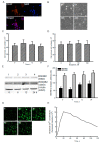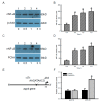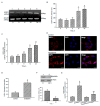The Bradykinin-BDKRB1 Axis Regulates Aquaporin 4 Gene Expression and Consequential Migration and Invasion of Malignant Glioblastoma Cells via a Ca2+-MEK1-ERK1/2-NF-κB Mechanism
- PMID: 32182968
- PMCID: PMC7139930
- DOI: 10.3390/cancers12030667
The Bradykinin-BDKRB1 Axis Regulates Aquaporin 4 Gene Expression and Consequential Migration and Invasion of Malignant Glioblastoma Cells via a Ca2+-MEK1-ERK1/2-NF-κB Mechanism
Abstract
Glioblastoma multiforme (GBM) is the most common form of brain tumor and is very aggressive. Rapid migration and invasion of glioblastoma cells are two typical features driving malignance of GBM. Bradykinin functionally prompts calcium influx via activation of bradykinin receptor B1/B2 (BDKRB1/2). In this study, we evaluated the roles of bradykinin in migration and invasion of glioblastoma cells and the possible mechanisms. Expressions of aquaporin 4 (AQP4) mRNA and protein were upregulated in human glioblastomas. Furthermore, exposure of human U87 MG glioblastoma cells to bradykinin specifically increased levels of BDKRB1. Successively, bradykinin stimulated influx of calcium, phosphorylation of MEK1 and extracellular signal-regulated kinase (ERK)1/2, translocation and transactivation of nuclear factor-kappaB (NF-κB), and expressions of AQP4 mRNA and protein. Concomitantly, migration and invasion of human glioblastoma cells were elevated by bradykinin. Knocking-down BDKRB1 concurrently decreased AQP4 mRNA expression and cell migration and invasion. The bradykinin-induced effects were further confirmed in murine GL261 glioblastoma cells. Therefore, bradykinin can induce AQP4 expression and subsequent migration and invasion through BDKRB1-mediated calcium influx and subsequent activation of a MEK1-ERK1/2-NF-κB pathway. The bradykinin-BDKRB1 axis and AQP4 could be precise targets for treating GBM patients.
Keywords: MEK1-ERK1/2-NF-κB; aquaporin 4; bradykinin-BDKRB1 axis; calcium influx; cell migration/invasion; glioblastoma.
Conflict of interest statement
All authors of this paper declare that they have no conflict of interest.
Figures






Similar articles
-
Mechanical stress facilitates calcium influx and growth of alveolar epithelial cells via activation of the BDKRB1/Ca2+/CaMKII/MEK1/ERK axis.Respir Res. 2025 Apr 28;26(1):168. doi: 10.1186/s12931-025-03240-7. Respir Res. 2025. PMID: 40296124 Free PMC article.
-
Activation of the human keratinocyte B1 bradykinin receptor induces expression and secretion of metalloproteases 2 and 9 by transactivation of epidermal growth factor receptor.Exp Dermatol. 2016 Sep;25(9):694-700. doi: 10.1111/exd.13038. Epub 2016 Jun 15. Exp Dermatol. 2016. PMID: 27093919
-
Role of aquaporin-4 in the regulation of migration and invasion of human glioma cells.Int J Oncol. 2011 Jun;38(6):1521-31. doi: 10.3892/ijo.2011.983. Epub 2011 Mar 21. Int J Oncol. 2011. PMID: 21424125
-
Role of KCa3.1 Channels in Modulating Ca2+ Oscillations during Glioblastoma Cell Migration and Invasion.Int J Mol Sci. 2018 Sep 29;19(10):2970. doi: 10.3390/ijms19102970. Int J Mol Sci. 2018. PMID: 30274242 Free PMC article. Review.
-
Natural Small Molecules Targeting NF-κB Signaling in Glioblastoma.Front Pharmacol. 2021 Aug 27;12:703761. doi: 10.3389/fphar.2021.703761. eCollection 2021. Front Pharmacol. 2021. PMID: 34512336 Free PMC article. Review.
Cited by
-
Anti-Inflammatory Effects of Rhamnetin on Bradykinin-Induced Matrix Metalloproteinase-9 Expression and Cell Migration in Rat Brain Astrocytes.Int J Mol Sci. 2022 Jan 6;23(2):609. doi: 10.3390/ijms23020609. Int J Mol Sci. 2022. PMID: 35054789 Free PMC article.
-
Kinin Receptors B1 and B2 Mediate Breast Cancer Cell Migration and Invasion by Activating the FAK-Src Axis.Int J Mol Sci. 2024 Oct 31;25(21):11709. doi: 10.3390/ijms252111709. Int J Mol Sci. 2024. PMID: 39519260 Free PMC article.
-
Enzalutamide Induces Apoptotic Insults to Human Drug-Resistant and -Sensitive Glioblastoma Cells via an Intrinsic Bax-Mitochondrion-Cytochrome C Caspase Cascade Activation Pathway.Molecules. 2022 Oct 7;27(19):6666. doi: 10.3390/molecules27196666. Molecules. 2022. PMID: 36235203 Free PMC article.
-
Methylpiperidinopyrazole Attenuates Estrogen-Induced Mitochondrial Energy Production and Subsequent Osteoblast Maturation via an Estrogen Receptor Alpha-Dependent Mechanism.Molecules. 2020 Jun 22;25(12):2876. doi: 10.3390/molecules25122876. Molecules. 2020. PMID: 32580515 Free PMC article.
-
Transmembrane water-efflux rate measured by magnetic resonance imaging as a biomarker of the expression of aquaporin-4 in gliomas.Nat Biomed Eng. 2023 Mar;7(3):236-252. doi: 10.1038/s41551-022-00960-9. Epub 2022 Nov 14. Nat Biomed Eng. 2023. PMID: 36376487
References
-
- Louis D.N., Perry A., Reifenberger G., Von Deimling A., Figarella-Branger D., Cavenee W.K., Ohgaki H., Wiestler O.D., Kleihues P., Ellison D.W. The 2016 World Health Organization classification of tumors of the central nervous system: A summary. Acta Neuropathol. 2016;131:803–820. doi: 10.1007/s00401-016-1545-1. - DOI - PubMed
Grants and funding
LinkOut - more resources
Full Text Sources
Miscellaneous

